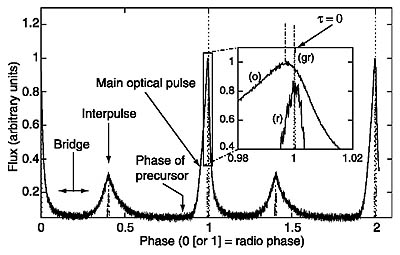ENHANCED OPTICAL
EMISSION DURING CRAB GIANT RADIO PULSES
WHT+TRIFFID
A correlation between optical and giant radio
pulse emission from the Crab pulsar was detected. Optical pulses coincident
with the giant radio pulses were on average 3% brighter than those coincident
with normal radio pulses. Combined with the lack of any other pulse profile
changes, this result indicates that both the giant radio pulses and the
increased optical emission are linked to an increase in the electron-positron
plasma density.
Despite more than 30 years of observation, the
emission mechanism of pulsars is still a matter of debate. A broad consensus
does exist: that the luminosity is powered by the rotation of the pulsar,
that the pulsed radio signal comes from a coherent process, and that the
optical–to–x-ray emission is incoherent synchrotron radiation, whereas the
γ-ray emission is curvature radiation. What is not agreed on is the mechanism
that accelerates the electrons to the energy required for synchrotron and
curvature radiation, where this acceleration takes place, how coherency is
maintained, and the stability of the electron-positron plasma outflow from
the neutron star's surface. From the radiopulse profile at 1380 MHz and the
optical profile for the Crab pulsar, two primary features can be identified:
a main pulse and an interpulse. At lower energies, a radio precursor can
be seen, and at higher energies in the optical, x-ray, and γ-ray regions,
bridge emission can be seen between the main pulse and the interpulse. One
suggestion is that the precursor represents emission from the pulsar polar
cap region near the neutron star surface, similar to the radio emission from
most pulsars, and that the other features come from higher in the magnetosphere.
This picture is made more complex by the existence of giant radio pulses
(GRPs) that occur at random intervals, in phase with either the main pulse
or the interpulse, and that have energies about 1000 times as high as the
mean energy. In the optical and infrared energy regions, the pulse profile
is constant at the 1% level.
Any observed variation in the emitted flux, pulse
morphology, or phase relations at higher energies coincident with a GRP would
provide explicit constraints on pulsar (coherent/incoherent) emission physics
and geometry. To investigate whether there is a link between the radio and
optical emission from the Crab pulsar, simultaneous observations were carried
out with the Westerbork Synthesis Radio Telescope (WSRT) and with the Transputer
Instrument for Fast Image Detection (TRIFFID) optical photometer mounted on
the William Herschel Telescope.

|
The Crab pulse profile showing
the optical light curve (o), the average radio light curve at 1380 MHz (r),
and a single giant pulse at 1357.5 MHz (gr). τ, time. Two periods are shown
for clarity. Various pulse parameters have been identified. Also shown is
the location of the precursor observed at lower frequencies and the bridge
emission seen particularly at higher frequencies. On this scale, the GRP width
corresponds to 0.00035 units of phase (12 µs), the radio pulse to 0.009(300
µs), and the optical pulse to 0.045 (1500 µs). The avalanche photodiode
(APD) band pass for these observations was from 6000 to 7500 Å. Phase
0 corresponds to the arrival at the solar system barycenter of the peak radio
pulse. The optical light curve for this plot was divided into 5000 phase
bins. [ JPEG | TIFF ]
|
A total of 10,034 optical data sets of 41 periods
each were collected. An average pulse profile was formed by folding the optical
photons at the Crab's period and then averaging over all data sets (but not
including the period associated with a GRP). By comparing the pulse profile
formed by averaging only the optical pulses coincident with a GRP astronomers
found that the giant optical pulses are on average 3% brighter than normal
optical pulses. They also analyzed other pulse parameters: arrival time,
pulse shape, and interpulse height. None of these parameters showed any statistically
significant variation with the presence of a GRP.
The fact that only the optical pulse, which is
coincident with a GRP, shows enhanced intensity suggests that the coherent
(radio) and incoherent (optical) emissions produced in the Crab pulsar's
magnetosphere are linked. A consistent explanation is that the optical emission
is a reflection of increased plasma density that causes the GRP event. Whatever
triggers the GRP phenomenon, it releases energy uniformly throughout most
of the electromagnetic spectrum, as implied by the similar energies of radio
and enhanced optical pulses. Changes in the pair production rate at the level
of a few percent could explain the optical variations. However, an additional
mechanism would be needed to account for the radio GRPs, which are orders
of magnitude stronger than the average pulse level. It has been suggested
that this could be achieved by local density enhancements to the plasma stream,
which increase the coherent emission ( n2) with little effect on the (high-energy) incoherent
radiation ( n2) with little effect on the (high-energy) incoherent
radiation ( n). These changes must occur on tiny time scales (<10 µs) to explain
the observed change in optical flux. Whatever the mechanism, these observations
demonstrate a clear link at the individual pulse level between the coherent
and incoherent emission regimes in the Crab pulsar. n). These changes must occur on tiny time scales (<10 µs) to explain
the observed change in optical flux. Whatever the mechanism, these observations
demonstrate a clear link at the individual pulse level between the coherent
and incoherent emission regimes in the Crab pulsar.
Some references:
|



